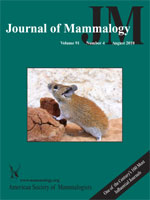The genus Myotis has undergone significant taxonomic revision since the advent of DNA sequencing techniques. Prior morphological examination of Myotis has indicated as many as 4 subgenera correlated with foraging strategies. Recent studies using mitochondrial DNA (mtDNA) sequence data have questioned the validity of these subgenera and have indicated that several taxa may require reevaluation as to their position within Vespertilionidae. Nevertheless, no study has used large-scale nuclear DNA sequencing to examine relationships within Myotis. We generated 4,656 base pairs (bp) of nuclear intron (PRKC1, STAT5A, and THY) and exon (APOB, DMP1, and RAG2) sequence data in addition to 2,866 bp of mtDNA sequence data to test previously hypothesized subgeneric groupings of Myotis. We included 21 species of Myotis from all morphological subgenera previously suggested, representatives of all subfamilies and tribes currently recognized in Vespertilionidae, and multiple representatives of all other families currently included in the superfamily Vespertilionoidea. We also included a representative of the rare African genus Cistugo, because significant doubt exists about its familial position. Our phylogenetic analyses did not support the morphologically defined Myotis subgenera and confirm that morphological similarities among Myotis are the result of convergent evolution. Divergence estimates derived from the total data set were concordant with previous studies, suggesting a middle Miocene trans-Beringian dispersal from Asia colonized North America, with subsequent South American colonization and diversification prior to the formation of the Isthmus of Panama 3–4 million years ago. Myotis latirostris fell outside of Myotis, and the high genetic distance separating it from other Myotis suggested that M. latirostris represented a distinct genus. The genus Cistugo, previously a subgenus within Myotis, fell basal to all vespertilionids, with a high genetic distance separating it from Vespertilionidae. We conclude that Cistugo should constitute a distinct family within Vespertilionoidea.
How to translate text using browser tools
16 August 2010
Molecular phylogenetics of Myotis indicate familial-level divergence for the genus Cistugo (Chiroptera)
Justin B. Lack,
Zachary P. Roehrs,
Craig E. Stanley,
Manuel Ruedi,
Ronald A. Van Den Bussche
ACCESS THE FULL ARTICLE

Journal of Mammalogy
Vol. 91 • No. 4
August 2010
Vol. 91 • No. 4
August 2010
Cistugo
mitochondrial DNA
molecular dating
Myotis
nuclear DNA
phylogenetics




